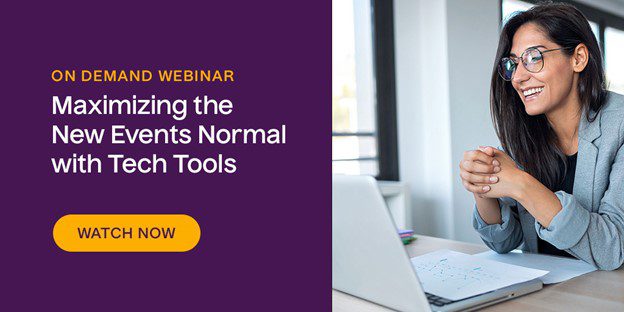By Daria Knupp, Content Marketing Manager
COVID-19 affected the events industry in a multitude of ways. From being forced to cancel events entirely to switching to virtual and reduced staffing, it seemed like new obstacles were popping up daily. Now, as cases caused by the Delta Variant rise, event professionals continue to face the unknown problem. As we have seen, many professionals have had to adapt to doing more with less. So, what do we do? Conclusion: there are tech tools that can help now and in the future when things return to normal.
In a recent webinar, Rich Vallaster, Director of Marketing and the Tradeshow Wonk at Personify, stressed just this – that we need to “let the tech, tech” and learn how to leverage new and existing solutions to improve efficiency and streamline operations.
Here are some of the biggest takeaways from the discussion.
Step 1: Focus on the Customer
As Vallaster stated early on in the webinar, “Sometimes we get caught up and forget that the customer is the one ultimately going through the experience.” He noted that retail did this very well during the pandemic by leveraging technology to meet their customers where they were. The event industry can take note, and Vallaster suggests starting a list of your buyers and with a simple list of questions that include:
- What steps and how many are involved in making a purchase/register?
- Can it be done entirely unaided, including payment and contracting if applicable?
- What barriers exist to the slow velocity?
- Do pre-COVID policies impact this velocity or deter a purchase? (i.e., cancellation policies, early-bird deadlines)
- Are there printed or non-dynamic materials that will date themselves quickly in a changing environment?
“Essentially, you need to review the buyer journey and determine if things still make sense in this environment,” Vallaster said. “And, if not, you need to adjust accordingly to meet the needs of the customer.”
Step 2: Perform an Audit of Your Current Technology
Now that you understand your customer, it is time to focus on the technology Vallaster stresses. He points out that according to Standish research, 80% of available software features are not utilized very often.
“You might have technology in place that you aren’t fully maximizing,” he added. “It is critical to audit your existing solution set. List all your current solutions and their primary purpose.”
Questions to consider are: “Are you using all of what you have, and what to capacity? Or do other departments have something that would work for you?
It is also important to identify what processes take you and the team the longest to conduct, and if there are features and functionalities that you could upgrade to improve or automate your processes. Overall, it’s about determining if there are untapped solutions that may help solve some of your problems.
Step 3: Take the Time to Strategize
“COVID taught us a lot, and we are still learning,” Vallaster says. “Items not in the cloud may become inaccessible at a moment’s notice. A lot of these things we just had in the office, and then we couldn’t be in the office.”
The work from home movement is changing how companies should think about things. Factors like contacts and colleagues may no longer be tied to a physical location. Now is the time to think about the key areas associated with not necessarily being in the office, such as:
Online Contracting
“It is time to move to online contracting? This helps prevent errors, and you can be sure you are adhering to current laws like the Electronic Signatures in Global and National Commerce Act (ESIGN). Plus, it is more convenient for the exhibitors and attendees,” Vallaster says.
Printed Materials
Whether it be printed show guides, floor plans, or sponsorship prospectus, print can be dated and invalid sometimes before it even rolls off the presses. Events continue to evolve more rapidly than previously, and because of this, anything print needs to be evaluated.
Vallaster points out that because of this, it makes more sense to move to digital. He cited Printweek, which reported that paper alone is going to increase 8 to 15% this year. Printing also takes time to produce, ship, and distribute.
“Digital allows for real-time information on all aspects of your events, which is extremely valuable,” he said. “And, let’s face it, digital is an expectation in the new events world, especially among digital natives.”
Mobile Apps
Vallaster states that mobile apps have seen a resurgence as a way to remain in the “hands” of audiences and a go-to source. As we move back from print, the mobile app will be more relevant. He believes mobile apps will eventually replace printed guides because they can be updated in real-time, and are less expensive. All event information can be found in one location on a device that people will always have.
Engagement
“We have always relied on a three-day event to satisfy connections and engagement with all our audiences,” Vallaster says. “We discovered in the virtual world that audiences want that interaction year-long.”
With COVID, we learned we need to diversify the investment and risks associated with in-person events. This is where event communities come in. This can help build excitement and engagement year-long. Not to mention that data you can collect from these communications is invaluable, and something you never had before.
Wrapping Up with Best Practices
Vallaster concludes by providing attendees considerations when maximizing technology, including asking partners on ways you can save money using their solutions, implementing fees to help offset the tech feels, and offering upsell opportunities.
“In the end, you need to let the tech, tech, but also understand that technology will never replace relationships. It will just provide you the time to deepen your relationships,” he concludes.
Click here to watch the webinar recording on how to maximize events with tech tools.
